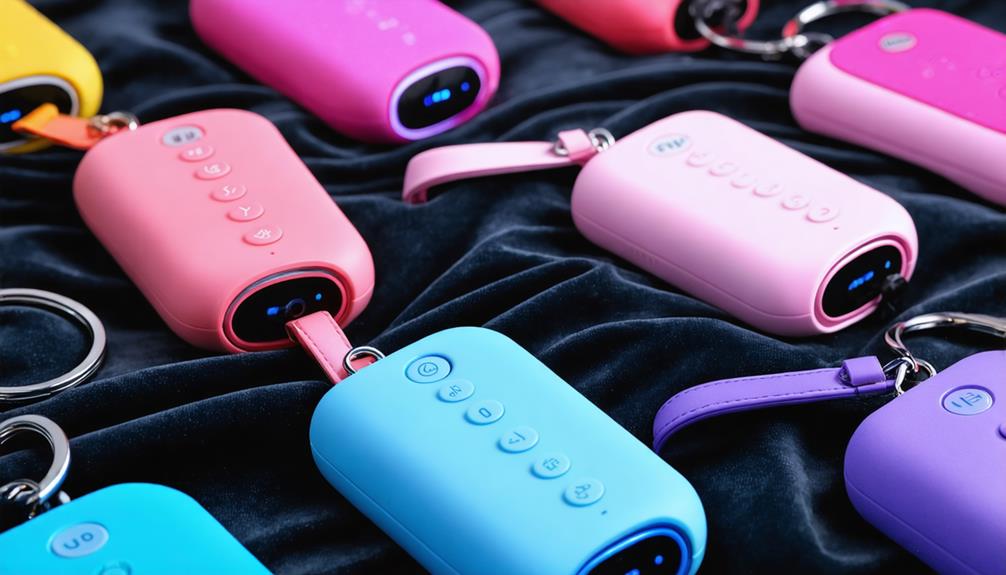
Brainstorm Security Shop

For Orders Over $199

On Any Of Our Products

Details On Refund Page
In an increasingly unpredictable world, personal alarms for women have emerged as critical tools for enhancing personal security. These devices, which emit high-decibel sounds to deter potential threats, are not merely gadgets but integral components of a comprehensive safety strategy. As they become more sophisticated, incorporating features like GPS tracking and app connectivity, the question arises: how do we navigate the diverse market to select the most suitable device? Understanding the nuances of personal alarms and their features is crucial for making an informed decision. But what should be the key considerations in this selection process?
Personal alarms serve as compact, portable devices designed to enhance personal safety by emitting a loud, attention-grabbing sound to deter potential threats. By creating an immediate disturbance, these alarms can provide users with the precious seconds needed to escape from dangerous situations.
The effectiveness of a personal alarm largely hinges on its ability to produce a sufficiently loud noise that can attract attention from bystanders and dissuade an assailant. Alarm effectiveness is often determined by the decibel level produced, with most devices emitting sounds above 100 decibels, comparable to the noise of a chainsaw or a rock concert.
However, the effectiveness isn’t solely about loudness. User experiences indicate that ease of use and accessibility are equally crucial. The alarm should be easily activated, even in high-stress situations, ensuring that it can function as intended when needed most.
User experiences also highlight the psychological benefits of carrying a personal alarm. Many users report feeling more confident and secure knowing they have a tool for self-defense readily available. This boost in confidence can be particularly empowering for women, as it encourages independence and peace of mind when navigating their daily environments.
When evaluating personal alarms for women, what key features should be prioritized to ensure optimal functionality and user satisfaction?
First and foremost, design considerations play a crucial role in the selection process. An ideal personal alarm should be compact and lightweight, allowing for easy portability without compromising on effectiveness. The aesthetics of the device should also align with user preferences, offering a discreet appearance that seamlessly integrates into everyday accessories like keychains or jewelry.
Ease of use is another vital feature; the activation mechanism should be intuitive, allowing for quick deployment in emergency situations. A loud, attention-grabbing alarm sound is essential, as it serves as both a deterrent to potential threats and a call for nearby assistance.
Battery life is an important consideration, ensuring the device remains reliable over extended periods without frequent recharging. Additionally, some users may prioritize alarms with additional features such as GPS tracking or mobile connectivity to enhance their sense of safety.
Customizable settings that cater to individual preferences can further enhance user satisfaction, providing a personalized experience. Ultimately, when selecting a personal alarm, balancing design elements with practical features ensures a product that meets both aesthetic desires and functional necessities.

Exploring the various types of personal alarms available on the market reveals a diverse array of options tailored to meet different user needs and preferences. These devices, designed as self defense tools, play a crucial role in emergency preparedness, offering reassurance and safety to women worldwide.
Among the various types, some personal alarms are sound-based, emitting a loud noise to deter potential threats and attract attention. Others incorporate advanced technology, such as GPS tracking, to alert designated contacts of the user’s location in real time.
A breakdown of personal alarm types includes:
Each type of personal alarm serves a distinct purpose, empowering women to take control of their safety through thoughtful selection and use.
Utilizing personal alarms offers multifaceted benefits that significantly enhance women’s safety and peace of mind. These devices serve as a crucial component in heightening safety awareness by providing an immediate response option during emergencies. When activated, personal alarms emit a loud sound that can deter potential threats, drawing attention to the user’s location and creating an opportunity to escape from danger. This immediate auditory cue not only startles potential aggressors but also alerts nearby individuals to the situation, fostering a community response.
Moreover, personal alarms complement self defense techniques by acting as a non-confrontational means of self-protection. While physical self defense methods require training and practice, personal alarms are straightforward to use, requiring no special skills. This makes them accessible to individuals of all ages and physical abilities, providing a layer of security for those who may not have mastered physical defense strategies.
In addition, the presence of a personal alarm can boost confidence, allowing women to navigate various environments with a greater sense of security. By integrating these devices into daily routines, women can proactively manage their safety, reducing the risk of harm and enhancing their overall well-being.

Selecting the appropriate personal alarm is a critical step in ensuring effective personal safety. In a market saturated with various devices, choosing the right alarm requires careful consideration of several factors to maximize both alarm effectiveness and accessibility.
A well-chosen personal alarm should be easy to carry and quick to activate, ensuring that it can be utilized in any situation without hesitation.
Key criteria to consider when selecting a personal alarm include:
To ensure longevity, regularly perform battery maintenance by checking and replacing batteries as needed. Implement cleaning tips such as gently wiping the device with a soft, damp cloth to remove dirt and prevent damage.
Legal restrictions on carrying personal alarms in public places vary by jurisdiction. Generally, personal alarms are permitted due to their non-weapon status. However, it’s advisable to consult local regulations for specific guidelines to ensure compliance.
Personal alarms can significantly enhance hiking safety and outdoor security by alerting nearby individuals in emergency situations. Their portability and ease of use make them an effective tool for ensuring personal safety in remote or challenging environments.
Personal alarms enhance emergency communication by utilizing alert technology that can integrate with broader emergency response systems. This integration ensures rapid response and coordination with emergency services, improving safety and reliability in urgent situations.
Discreetly carrying a personal alarm can be achieved by integrating it into fashion accessories such as necklaces or bracelets, or by utilizing hidden pockets in clothing or bags, ensuring accessibility without compromising personal style or security.
In conclusion, personal alarms serve as vital tools in enhancing women’s personal security by providing an immediate response mechanism in threatening situations. These devices, characterized by their loud sound emissions and user-friendly designs, effectively deter potential threats and draw attention when needed. Various types, such as keychain and wearable models, offer discreet yet accessible protection. By integrating personal alarms into daily life, individuals can proactively address safety concerns, fostering a sense of empowerment and confidence in diverse environments.
